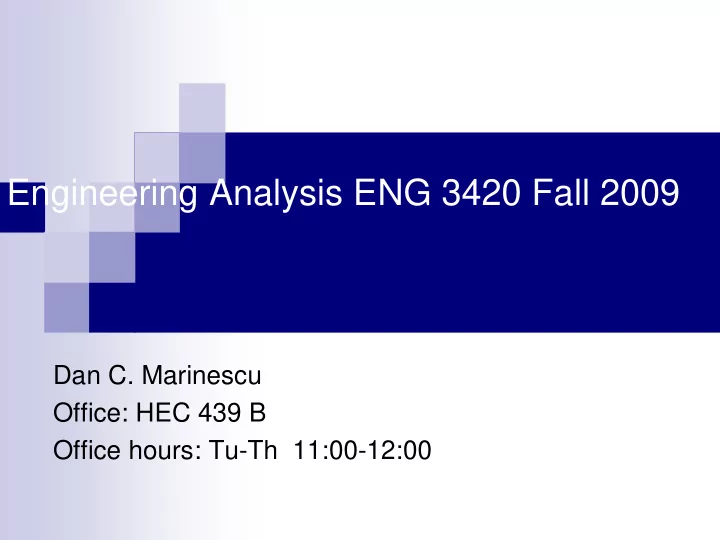

Engineering Analysis ENG 3420 Fall 2009 Dan C. Marinescu Office: HEC 439 B Office hours: Tu-Th 11:00-12:00
Lecture 15 � Last time: � Discussion of pivoting � Tri-diagonal system solver � Examples � Today: � Symmetric matrices; Hermitian matrices. � Matrix multiplication � Non-commutative � Associative � The transpose of a product of two matrices � LU Factorization (Chapter 10) � Cholesky decomposition � Next Time � Midterm Lecture 15 2
LU Factorization � LU factorization involves two steps: � Decompose the [ A ] matrix into a product of: a lower triangular matrix [ L ] with 1 for each entry on the diagonal. � � and an upper triangular matrix [ U � Substitution to solve for { x } � Gauss elimination can be implemented using LU factorization � The forward-elimination step of Gauss elimination comprises the bulk of the computational effort. � LU factorization methods separate the time-consuming elimination of the matrix [ A ] from the manipulations of the right-hand-side [ b ].
Gauss Elimination as LU Factorization � To solve [ A ]{ x }={ b }, first decompose [ A ] to get [ L ][ U ]{ x }={ b } � MATLAB’s lu function can be used to generate the [ L ] and [ U ] matrices: [ L , U ] = lu( A ) � Step 1 � solve [ L ]{ y }={ b }; { y } can be found using forward substitution. � Step 2 � solve [ U ]{ x }={ y }, { x } can be found using backward substitution. � In MATLAB: [L, U] = lu(A) d = L\b x = U\d � LU factorization � requires the same number of floating point operations (flops) as for Gauss elimination. � Advantage � once [ A ] is decomposed, the same [ L ] and [ U ] can be used for multiple { b } vectors.
Cholesky Factorization � A symmetric matrix � a square matrix, A, that is equal to its transpose: A = A T ( T stands for transpose). � The Cholesky factorization � based on the fact that a symmetric matrix can be decomposed as: [ A ]= [ U ] T [ U ] � The rest of the process is similar to LU decomposition and Gauss elimination, except only one matrix, [ U ], needs to be stored. � Cholesky factorization with the built-in chol command: U = chol(A) � MATLAB’s left division operator \ examines the system to see which method will most efficiently solve the problem. This includes trying banded solvers, back and forward substitutions, Cholesky factorization for symmetric systems. If these do not work and the system is square, Gauss elimination with partial pivoting is used.
Recommend
More recommend